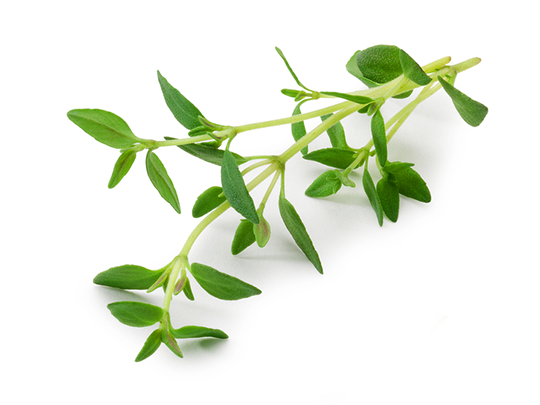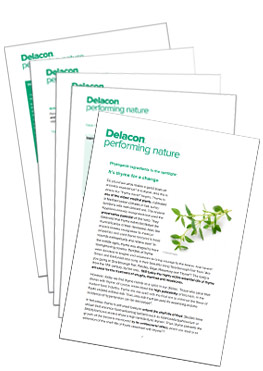It’s thyme for a change (part 1)
Hello February. A new month has started and the timing is perfect to put another phytogenic substance into the spotlight. Our next herb might look unspectacular and with its small green leaves very similar to other herbs. However, it can be a real game changer in human as well as animal nutrition. What is the ingredient we are talking about? It’s thyme to find out.
Let’s get started and come with us on a journey through thyme: Whether as a medicinal plant or as a spice – hardly any herb can be used more versatilely to meet present and future challenges. After reading this first part of our series you will know about the possibilities of using this fascinating herb. Dive deeper into the world of thyme in the second and third part and learn more about its active substances and their effects on intestinal health.

Do you know what makes a good pizza an aromatic experience? It is thyme. And this is where our “thyme travel” begins. Thyme is one of the oldest medical plants, cultivated in Mediterranean climates in hot, sunny locations with well-drained soil. The ancient Egyptians already recognized and used the preservative potential of this herb: They observed that thyme balms facilitated the mummification of their deceased. Also, the ancient Greeks recognized its medical properties and used thyme tinctures to treat wounds antiseptically and relieve pain. In the middle ages, thyme was alleged to have strengthening powers. Bundles of thyme were donated to knights and noblemen to bring courage to the bearer.
And haven’t Simon and Garfunkel also sung in their beautiful song ‘Scarborough Fair’ from “Are you going to Scarborough Fair, Parsley, Sage, Rosemary and Thyme”? The song is from the 17th century, by the way. Still today the highly active essential oils of thyme are used for the treatment of coughs, diarrhea and headaches.

However, today we find thyme mainly as a spice in our dishes: Those who spice their dishes with thyme, of course, know about the high palatability of this herb. In the modern food industry, thyme oils are used with the final aim to enhance the flavor of foods cooked without salt. Thus, less salt must be used for seasoning and the incidence of hypertension can be decreased.
In hot areas, thyme is still used today to extend the shelf life of food. Studies have shown that common food-poisoning bacteria such as Salmonella typhimurium or Staphylococcus aureus show a high sensitivity to thyme. Thus, thyme prevents the growth of the bacteria mentioned by its antibacterial effect, which can lead to an extension of the shelf life of foods seasoned with thyme.
Moreover, the ingredient substance thymol is also used in commercial formulation for its repellent effect against mosquitoes. Throughout the ages, thyme has served the people well and we can still benefit today.

For thousands of years, it is the absolute superstar in herb gardens: Thyme. Whereas there are more than 200 different thyme species, only two are of agronomic importance: The small bushy shrub Thymus vulgaris with a height up to 40 cm, belonging to the Lamiaceae family, also grows wild in nature, especially in central Europe, the Mediterranean region or in the Caucasus. Whereas its relative Thymus zygis L. occurs only in the Iberian Peninsula. While Thymus vulgaris has recurved branches and elongated smooth leaflets, those of Thymus zygis are fine, whitish-hairy. The small, white to light pink blossoms of this fascinating herb have a lemon-like fragrance.
Thyme is a pioneer and a true survivor: this endurable plant does not only tolerate heavy periods of droughts; even very low temperatures do not destroy it. Some wild varieties of thyme can already be found in lofty heights of 2500 meters on mountain tops.
The healing effect of thyme has been known for many centuries as shown in the introduction. Thyme, therefore, is often used in traditional medical cough teas, cough remedy and cold baths. In fact, the plant is a versatile helper in many diseases and aliments. However, already in the medieval medicine, it was recommended for pain in the chest, appetite stimulation, indigestion or wound treatment.
References upon request
Let’s have a closer look on this powerful herb
Do you want the entire article as PDF including all references?

You are only one click away.

Anne Oberdorf
Anne has always been fascinated by the unknown, the diversity and beauty of nature. Her love for nature brought her to Delacon in 2018 after studying agricultural sciences, where she worked as Technical Communications Manager and later as Product Manager Aquaculture. Since February 2021, she has been taking a new, natural career path outside of Delacon.










